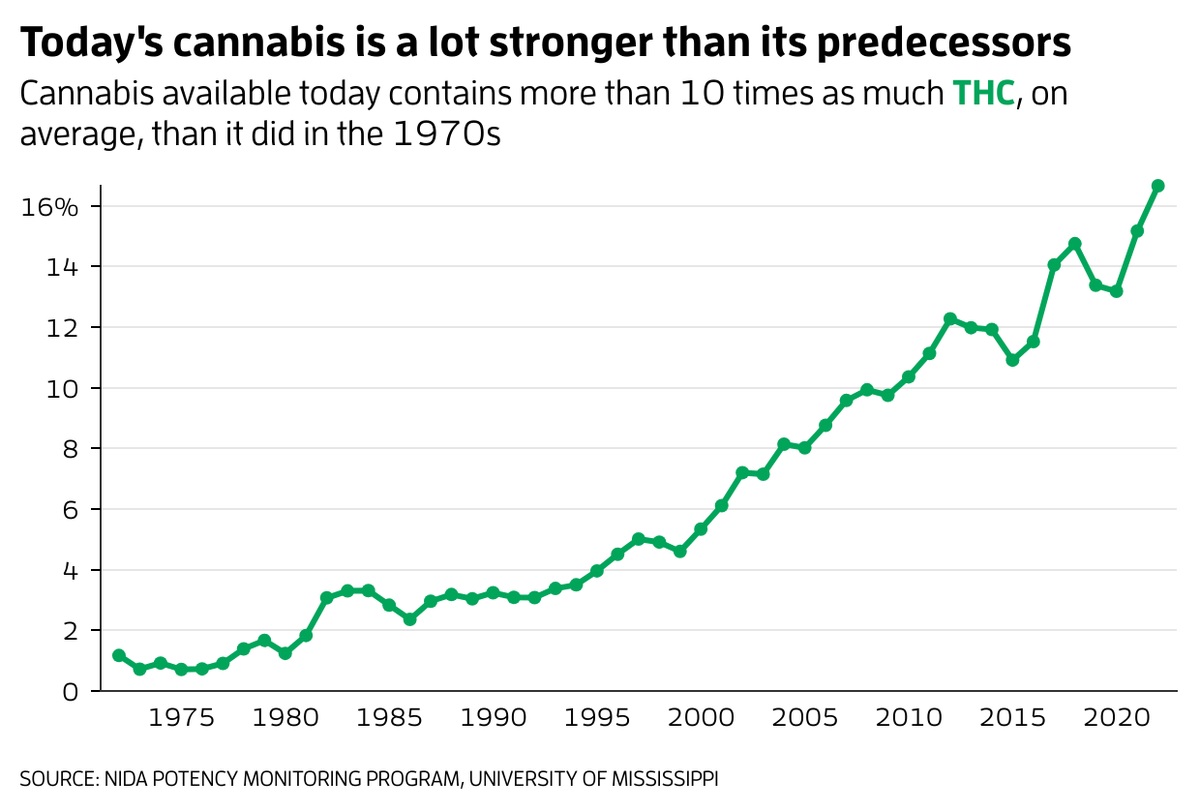We use cookies to make your experience better. To comply with the new e-Privacy directive, we need to ask for your consent to set the cookies. Learn more.
The Potent Evolution: Unveiling the Strength of Today's Cannabis
The Potent Evolution: Unveiling the Strength of Today's Cannabis
Introduction
The landscape of cannabis has undergone a remarkable transformation over the past few decades, with one of the most notable changes being the dramatic increase in the potency of the plant's psychoactive compound, tetrahydrocannabinol (THC). As we step into the future, the cannabis of today is vastly different from the weed of the past, leaving researchers, regulators, and consumers alike grappling with the implications of this potent evolution.
The Rise of THC Potency
The data is clear: over the last 50 years, the average THC content in cannabis has increased more than tenfold. This trend is not limited to the United States, as studies have shown similar patterns of rising THC concentrations across the globe, including in countries like the UK, the Netherlands, France, Denmark, and New Zealand.
Advances in Cultivation Techniques
One of the primary drivers behind this surge in potency is the evolution of cannabis cultivation techniques. Growers have adopted increasingly sophisticated methods, employing advanced lighting systems, precise nutrient regimens, and sophisticated environmental controls to optimize plant growth and cannabinoid production. This level of precision has allowed for the cultivation of strains with specific, high-THC profiles.
Selective Breeding and Genetics
Alongside the technological advancements, breeders have also harnessed the power of selective breeding to enhance the potency of cannabis. By meticulously crossing strains with desirable characteristics, they have developed offspring with even greater THC concentrations, some exceeding 30% or more.
Understanding Cannabinoid Profiles
As our scientific understanding of the cannabis plant has grown, we've gained a deeper appreciation for the complex interplay of its various cannabinoids. While THC was once the primary focus, we now know that there are over 100 distinct cannabinoids, each with its own unique effects. This knowledge has enabled breeders to cultivate strains with specific cannabinoid profiles, further driving the evolution of potent cannabis.

Shifting Consumer Preferences
The increased availability of high-THC cannabis products has also been fueled by changing consumer preferences. As cannabis legalization has spread, consumers have access to a wider variety of products, and many are seeking out the most potent experiences. This demand has led the market to respond with an array of concentrated forms, such as dabs and oils, that can contain up to 90% THC.
The Entourage Effect
However, as the focus on THC potency has intensified, there is a growing recognition of the importance of the "entourage effect." This phenomenon suggests that the synergistic interplay of various cannabinoids and terpenes can produce a more well-rounded and nuanced experience than high THC alone. Consequently, some consumers are now seeking out strains that offer a diverse range of compounds, rather than just maximizing THC content.
Legalization and Regulation
The legalization and regulation of cannabis have also played a crucial role in the evolving landscape of potency. As governments establish legal frameworks for cannabis production and distribution, they often require testing and labeling of products, including THC and CBD content. This transparency helps consumers make informed choices and encourages producers to meet or exceed potency expectations.
Balancing Potency and Safety
However, the rapid increase in cannabis potency has also raised concerns about the potential risks and safety implications. As THC levels have soared, researchers have warned about the increased likelihood of unpleasant or dangerous side effects, such as nausea, vomiting, paranoia, and abnormal heart rhythms. This has underscored the need for comprehensive, controlled studies to better understand the therapeutic and adverse effects of these potent cannabis products.
The Challenges of Research and Regulation
Despite the growing body of evidence surrounding the potential risks of high-potency cannabis, the scientific community has faced significant challenges in conducting rigorous research on the topic. Historically, the federal government has imposed obstacles that have hindered researchers' ability to investigate the impacts of cannabis, particularly in the United States.
Limitations in Research
The limited availability of high-quality scientific data has made it difficult to develop a clear understanding of the safety and long-term implications of the increasingly potent cannabis products. Researchers have highlighted the need for comprehensive studies that evaluate the therapeutic benefits and adverse effects of these substances, especially as they relate to brain development, mental health, and cardiovascular health.
Regulatory Gaps and Inconsistencies
The rapid pace of cannabis legalization and commercialization has also outpaced the development of effective regulatory frameworks. Inconsistencies in laws and policies across different jurisdictions have created a patchwork of regulations, making it challenging to ensure the safety and quality of cannabis products. This has raised concerns about the potential for the cannabis industry to follow a similar trajectory as the tobacco industry, where commercial interests have often taken precedence over public health.
The Future of Cannabis Potency
As the world continues to grapple with the implications of the evolving cannabis landscape, it is clear that the future will bring further changes and challenges. While the focus on increasing THC potency has been a significant trend, there are signs that the industry may begin to shift towards a more balanced approach, prioritizing the entourage effect and the therapeutic potential of a wider range of cannabinoids.
Emerging Cannabinoids and Therapeutic Potential
In addition to THC and CBD, researchers are increasingly exploring the potential of other cannabinoids, such as CBG and CBN, which may offer unique therapeutic benefits. As the understanding of the cannabis plant's complex chemistry continues to deepen, we may see a trend towards breeding for specific therapeutic effects, opening up new avenues for medical cannabis use.
Regulatory Oversight and Consumer Education
To ensure the responsible development of the cannabis industry, there will likely be a greater emphasis on regulatory oversight and consumer education. Policymakers and public health authorities will need to work closely with the scientific community to establish evidence-based guidelines and standards that prioritize safety and public health. Additionally, efforts to educate consumers about potency, dosage, and the nuanced effects of cannabis will be crucial in empowering individuals to make informed choices.
Conclusion
The story of cannabis potency is one of rapid evolution, driven by advancements in cultivation techniques, selective breeding, and changing consumer preferences. As the world grapples with the implications of this potent transformation, the need for comprehensive research, effective regulation, and consumer education has never been more pressing.
By embracing a balanced and evidence-based approach, the cannabis industry and the broader scientific community can work together to harness the therapeutic potential of this remarkable plant while mitigating the risks associated with its increasing strength. The future of cannabis potency may hold both challenges and opportunities, but one thing is certain: the cannabis of today is a far cry from the weed of the past.


